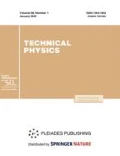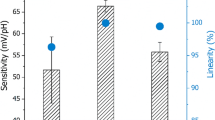Abstract
We have proposed a mathematical model of the sensor response of vacuummeters with sensitive elements based on broadband semiconductor oxide with electrical conductivity of the n- and p-type, as well as the multicomponent oxide systems. The correctness of the model description of the dependence of the resistivity of nanomaterials synthesized by the sol–gel method and has the structure of spherical aggregates of fractal origin on the ambient pressure has been demonstrated. It has been shown that, taking into account the corrections, the developed model can be used to qualitatively describe the sensor response of nanomaterials based on two-component SiO2—SnO2 oxide systems with a labyrinth structure.
Similar content being viewed by others
References
O. A. Shilova, Glass Technol. 45, 1 (2004).
A. S. Komolov, N. B. Gerasimova, E. V. Lazneva, S. A. Komolov, and I. Z. Buzin, Rus. J. Appl. Chem. 83, 835 (2010).
V. A. Moshnikov, I. E. Gracheva, V. V. Kuznezov, A. I. Maximov, S. S. Karpova, and A. A. Ponomareva, J. Non-Cryst. Solids 356, 2020 (2010).
V. A. Moshnikov, S. S. Nalimova, and B. I. Seleznev, Semiconductors 48, 1499 (2014).
M. P. Fedotova, G. A. Voronova, E. Yu. Emel’yanova, N. I. Radishevskaya, and O. V. Vodyankina, Zh. Fiz. Khim. 83, 1539 (2009).
I. A. Pronin, N. V. Kaneva, A. S. Bozhinova, I. A. Averin, K. I. Papazova, D. Ts. Dimitrov, and V. A. Moshnikov, Kinet. Catal. 55, 167 (2014).
A. B. Yaroslavtsev, Usp. Khim. 78, 1094 (2009).
S.-J. Chang, T.-J. Hsueh, C.-L. Hsu, Y. R. Lin, I.-C. Chen, and B.-R. Huang, Nanotechnology 19, 095505 (2008).
Liming Wu, Fang Fang Song, Xuxiong Fang, Zhi-Xin Guo, and S. Liang, Nanotechnology 21, 475502 (2010).
V. B. Kapustyanyk, M. R. Panasyuk, B. I. Turko, Yu. G. Dubov, and R. Ya. Serkiz, Semiconductors 48, 1395 (2014).
I. A. Averin, S. E. Igoshina, V. A. Moshnikov, A. A. Karmanov, I. A. Pronin, and E. I. Terukov, Tech. Phys. 60, 928 (2015).
X. J. Zheng, X. C. Cao, J. Sun, B. Yuan, Q. H. Li, Z. Zhu, and Y. Zhang, Nanotechnology 22, 435501 (2011).
R. B. Vasil’ev, L. I. Ryabova, M. N. Rumyantseva, and A. M. Gas’kov, Usp. Khim. 73, 1019 (2004).
V. V. Krivetskii, M. N. Rumyantseva, and A. M. Gas’kov, Usp. Khim. 82, 917 (2013).
S. E. Igoshina, I. A. Averin, and A. A. Karmanov, Vestn. Ryazanskogo Gos. Radiotekh. Univ., No. 48, 115 (2014).
I. A. Pronin and M. V. Goryacheva, Surf. Coat. Technol. 235, 835 (2013).
V. V. Kisin, V. V. Sysoev, S. A. Voroshilov, and V. V. Simakov, Semiconductors 34, 308 (2000).
R. Zhyul’en, Usp. Fiz. Nauk 157, 339 (1989).
M. N. Rumyantsev, “Chemical modification and sensory properties of nanocrystalline tin dioxide,” Candidate’s Dissertation (Moscow, 2009).
A. Zima, A. Köck, and T. Maier, Microelectron. Eng. 87, 1467 (2010).
Sensors and “Smart” Molecular Nanostructures: Component for Future Information Technologies, Ed. by W. Gopel, J. Hesse, and J.N. Zemel (VCH, Weinheim, 1995), Vol.8.
V. V. Sysoev, “Multisensor systems of gas recognition based on metal-oxide thin films and nanostructures,” Candidate’s Dissertation (Saratov, 2009).
A. Fort, M. Mugnaini, S. Rocchi, M. B. Serrano-Santos, V. Vignoli, and R. Spinicci, Sens. Actuators, B 124, 245 (2007).
Author information
Authors and Affiliations
Corresponding author
Additional information
Original Russian Text © I.A. Averin, S.E. Igoshina, A.A. Karmanov, I.A. Pronin, V.A. Moshnikov, E.I. Terukov, 2017, published in Zhurnal Tekhnicheskoi Fiziki, 2017, Vol. 87, No. 5, pp. 780–787.
Rights and permissions
About this article
Cite this article
Averin, I.A., Igoshina, S.E., Karmanov, A.A. et al. Simulation of the sensor response of vacuummeters with sensitive elements based on multicomponent oxide nanomaterials with the fractal structure. Tech. Phys. 62, 799–806 (2017). https://doi.org/10.1134/S1063784217050061
Received:
Published:
Issue Date:
DOI: https://doi.org/10.1134/S1063784217050061




